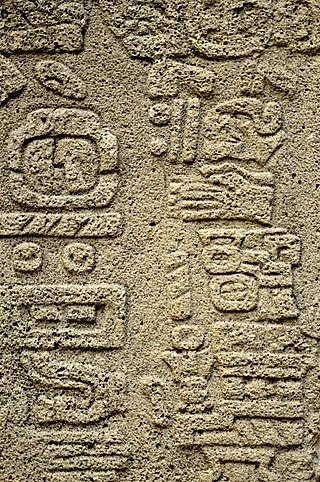Related Research Articles

The Zapotec are an Indigenous people of Mexico. Their population is primarily concentrated in the southern state of Oaxaca, but Zapotec communities also exist in neighboring states. The present-day population is estimated at 400,000 to 650,000, many of whom are monolingual in one of the Native Zapotec languages and dialects.

In Zapotec cultures of Oaxaca, a muxe is a person assigned male at birth who dresses and behaves in ways otherwise associated with women; they may be seen as a third gender.

The Zapotec languages are a group of around 50 closely related indigenous Mesoamerican languages that constitute a main branch of the Oto-Manguean language family and are spoken by the Zapotec people from the southwestern-central highlands of Mexico. A 2020 census reports nearly half a million speakers, with the majority inhabiting the state of Oaxaca. Zapotec-speaking communities are also found in the neighboring states of Puebla, Veracruz, and Guerrero. Labor migration has also brought a number of native Zapotec speakers to the United States, particularly in California and New Jersey. Most Zapotec-speaking communities are highly bilingual in Spanish.

Isthmus Zapotec, also known as Juchitán Zapotec, is a Zapotec language spoken in Tehuantepec and Juchitán de Zaragoza, in the Mexican state of Oaxaca. According to the census of 1990 it has about 85,000 native speakers, however this number is rapidly decreasing, as speakers shift to Spanish.
A macrolanguage is a group of mutually intelligible speech varieties, or dialect continuum, that have no traditional name in common, and which may be considered distinct languages by their speakers. Macrolanguages are used as a book-keeping mechanism for the ISO 639 international standard of language codes. Macrolanguages are established to assist mapping between different sets of ISO language codes. Specifically, there may be a many-to-one correspondence between ISO 639-3, intended to identify all the thousands of languages of the world, and either of two other sets, ISO 639-1, established to identify languages in computer systems, and ISO 639-2, which encodes a few hundred languages for library cataloguing and bibliographic purposes. When such many-to-one ISO 639-2 codes are included in an ISO 639-3 context, they are called "macrolanguages" to distinguish them from the corresponding individual languages of ISO 639-3. According to the ISO,
Some existing code elements in ISO 639-2, and the corresponding code elements in ISO 639-1, are designated in those parts of ISO 639 as individual language code elements, yet are in a one-to-many relationship with individual language code elements in [ISO 639-3]. For purposes of [ISO 639-3], they are considered to be macrolanguage code elements.

The Zapotec civilization is an indigenous pre-Columbian civilization that flourished in the Valley of Oaxaca in Mesoamerica. Archaeological evidence shows that their culture originated at least 2,500 years ago. The Zapotec archaeological site at the ancient city of Monte Albán has monumental buildings, ball courts, tombs and grave goods, including finely worked gold jewelry. Monte Albán was one of the first major cities in Mesoamerica. It was the center of a Zapotec state that dominated much of the territory which today is known as the Mexican state of Oaxaca.

The Zapotec script is the writing system of the Zapotec culture and represents one of the earliest writing systems in Mesoamerica. Rising in the late Pre-Classic era after the decline of the Olmec civilization, the Zapotecs of present-day Oaxaca built an empire around Monte Albán. One characteristic of Monte Albán is the large number of carved stone monuments one encounters throughout the plaza. There and at other sites, archaeologists have found extended text in a glyphic script.
Mixtepec Zapotec is an Oto-Manguean language of Oaxaca, Mexico. It is reported to have 80% intelligibility with Lapaguía Zapotec, but with only 45% intelligibility in the other direction.
Zaniza Zapotec is an Oto-Manguean language of western Oaxaca, Mexico. It is one of several Zapotec languages called Papabuco. It has only 10% intelligibility with Texmelucan Zapotec, its closest important relative.
Lachixío Zapotec is a Zapotec language of Oaxaca, Mexico. It is spoken in the Sola de Vega District by around 3000 speakers in Santa María Lachixío and San Vicente Lachixío. While many other Zapotec languages have suffered major language shifts to Spanish, most children in these towns are raised with Zapotec and learn Spanish at an early age.
Tlacolula Valley Zapotec or Valley Zapotec, known by its regional name Dizhsa, and formerly known by the varietal name Guelavia Zapotec is a Zapotec language of Oaxaca, Mexico.
Ocotlán Zapotec is a Zapotec language of Oaxaca, Mexico.
Chichicapan Zapotec is a Zapotec language of Oaxaca, Mexico. The town's name is spelled as both Chichicápam and Chichicapan.
Elotepec Zapotec is a Zapotec language of a single village in western Oaxaca, Mexico, San Juan Elotepec in the Municipio of Villa Sola de Vega. It is one of several Zapotec languages called Papabuco, and has 68% intelligibility of Zaniza Zapotec.
Yalálag Zapotec is a Zapotec language of Oaxaca, Mexico, spoken in Hidalgo Yalalag, Mexico City, Oaxaca City, Veracruz.
Ixtlán Zapotec is a Zapotec dialect cluster of Oaxaca, Mexico.
Lapaguía Zapotec, or Lapaguía-Guivini Zapotec, is a Zapotec language spoken in southern Oaxaca, Mexico.
Coatecas Altas Zapotec is a Zapotec language spoken in southern Oaxaca, Mexico, in and around the town of Coatecas Altas, in the Ejutla District, south of Oaxaca City. It is 83% intelligible with Ozolotepec Zapotec, and similar to Miahuatlán Zapotec.
Ozolotepec Zapotec is a Zapotec language spoken in southern Oaxaca, Mexico. It is partially intelligible with Cuixtla Zapotec and Loxicha Zapotec.
Quiegolani Zapotec is a Zapotec language of Oaxaca, Mexico.
References
- ↑ Quiatoni Zapotec at Ethnologue (18th ed., 2015) (subscription required)